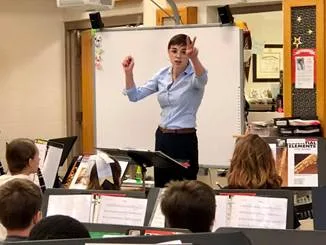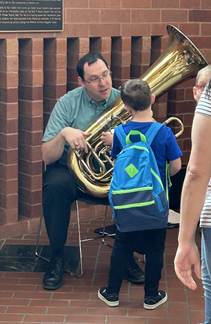Universities are deeply woven into the fabric of their communities, contributing to everything from athletics to service and business. Music is no exception. Higher education institutions often collaborate with local schools and organizations in ways that are formal or informal, curricular or extracurricular, observatory or interactive. Given that each partnership represents the unique strengths and needs of the community and music institution, my goal is to highlight two examples from the University of Oklahoma (OU) that reflect the positive attributes of community music education.
College Classes in the Public School Music Room
Upon joining the OU music education faculty in 2014, I was tasked with leading a major curriculum revision to our undergraduate degree in instrumental music education. We restructured our methods course sequence, yet we did not want to sacrifice time in which preservice music teachers (PSMTs) could instruct and interact with children. I reached out to then Fine Arts Coordinator of Norman Public Schools (NPS) Dr. Brad Benson, who shared my passion for building relationships between collegiate and P–12 students. We envisioned a one-of-a-kind experience: an instrumental methods course that would meet in NPS instrumental music classrooms, where authentic teaching and learning could occur.
Our course meets twice per week in either a middle school band or a strings classroom. OU music education faculty members introduce a topic and facilitate discussion and an activity for the first 20 minutes of our class. When the bell rings, students arrive for their regular rehearsal. Each day, our college students are afforded the opportunity to teach by leading a warm-up, an exercise from the technique/method book, or a section of a concert piece. Our PSMTs sit in with the students during rehearsal (playing secondary instruments). They provide individual feedback to students, lead “pull out” sectionals, and observe both children and the school music educator as they interact in their regular environment. The faculty member travels around the rehearsal, guiding our PSMTs through their instructional experiences and taking notes for discussion in the subsequent class meeting.

Our college students benefit from working with children in their daily learning environment. The P–12 students receive a wealth of feedback and, oftentimes, more individual instruction than ensemble directors can deliver on a regular basis. For the host teacher, the collaborative planning (technique book examples/etudes, rehearsal/performance literature, instructional schedules) affords them an opportunity to work as a university-level music teacher educator. For our faculty members, they remain embedded in the daily life of public school music education.
Our methods course experience has become a cornerstone of our instrumental music education curriculum. It serves as an effective “bridge” to the student teaching experience that follows, better preparing our PSMTs for building relationships with students and integrating them into an existing school instrumental music classroom. I encourage band and orchestra teachers to peruse similar collaborative endeavors, which benefit all parties in this partnership.
Sensory-Friendly Concerts

My colleague Dr. Caroline Hand joined our band faculty in 2022. One of the most impactful things Caroline has developed in her short time at OU is the sensory-friendly concert series. These on-campus performances are designed specifically for school-aged students with special needs, who are afforded a safe and interactive environment in which they attend a concert in our formal performance space.
Sensory-friendly concerts include everything from visual images (projected above the ensemble) to balloons and inflatable balls to “lights-up” performance. Children are encouraged to react however they feel moved to do so: stimming, feeling the vibrations of the music through the inflatables, wearing protective earwear, dancing, and even coming up on stage. The welcoming environment presents a unique opportunity for these children to participate in a musical experience in ways they know how and that likely would not be afforded in a traditional concert setting.
The past few years, Caroline has invited different school districts to attend our sensory-friendly concerts (held during the school day), expanded the series to feature two of our university ensembles (one on each concert), and included a post-concert “instrument petting zoo” led by OU music students—the same ones who perform in the ensemble. This experience allows the children to hold and play an instrument, while giving our collegiate musicians the opportunity to interact directly with their audience members. I have never seen so many smiles on faces, those of both the children and our students. The sensory-friendly concerts have become a much-anticipated annual event by both entities.
Conclusion
As a career music educator and leader of our New Horizons Band, I remain a firm believer in the power of lifelong music making. The benefits of collaborative partnerships are robust, positively influencing the community and the future of the music education profession. I challenge school band and orchestra directors to seek out collaborative opportunities with local higher education institutions. Be creative, be brave, and lead by example!















